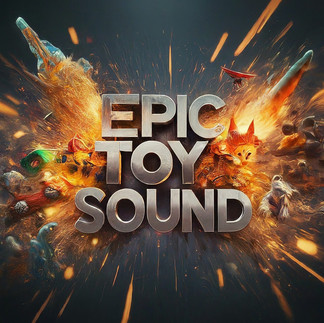Zillion Instrumentals & Epic Toy Sound Make History: Paying Royalties for Album Art to Toy Photographers
- Action Figure Guild

- Jul 10, 2024
- 5 min read
Updated: May 19
Zillion Instrumentals & Epic Toy Sound Make History: Paying Royalties for Album Art to Toy Photographers
In a groundbreaking move, independent record labels Zillion Instrumentals and Epic Toy Sound are changing the game for visual artists, particularly those in the toy photography and content creation communities. For the first time in the music industry, these labels are paying royalties for album artwork, with a direct 50/50 split of the earnings generated.
What This Means for Artists
Historically, visual artists have often been overlooked when it came to royalty payments. Their essential contributions to album covers, promotional materials, and social media content were often treated as a one-time fee. This new model from Zillion Instrumentals and Epic Toy Sound recognizes the ongoing value that artwork brings to a project's success.
The Unseen Creators: How Cover Art Was (and Often Still Is) Paid
For decades, the role of visual artists in the music industry has been somewhat paradoxical. On the one hand, their work – album covers, promotional materials, music videos – is undeniably crucial. A well-designed cover can be iconic, instantly recognizable, and a major factor in an album's success. Think of the instantly recognizable lips on The Rolling Stones' Sticky Fingers or the stark, powerful image of a baby swimming underwater on Nirvana's Nevermind. These images are as ingrained in music history as the music itself.
On the other hand, photographers and artists have traditionally been treated more like hired guns than collaborators. In most cases, they are paid a one-time fee for their work, with no stake in the album's future sales or streaming success. This means they don't benefit financially if the album goes platinum, even though their artwork is a key part of the package that sells.
There are a few exceptions, of course. Established artists who create album covers might be able to negotiate a royalty deal, especially if their name recognition adds value to the project. But for most photographers and content creators, a one-time fee is the standard. This can be a particularly raw deal for lesser-known artists whose work ends up propelling an album to success.
A Brief Journey Through Album Art History
The history of album art is as rich and varied as the music it accompanies. From the early days of vinyl records to the digital age, album covers have evolved in style and function, but their importance has never wavered.
Early Days of Vinyl: In the early 20th century, album covers were simple and often generic, primarily serving to protect the record. As music genres like jazz and rock and roll gained popularity, album art became more adventurous, reflecting the energy and spirit of the times.
The Psychedelic Era: The 1960s brought an explosion of creativity in album art, with psychedelic designs, vibrant colors, and surreal imagery becoming synonymous with the era's music. Album covers like the Beatles' "Sgt. Pepper's Lonely Hearts Club Band" and Pink Floyd's "The Dark Side of the Moon" became iconic symbols of the cultural revolution.
The Digital Age: With the rise of digital music, album art faced new challenges. The smaller format of digital displays initially led to a decline in the prominence of album covers. However, the resurgence of vinyl and the importance of visual branding in the digital age have renewed interest in album art, leading to innovative designs that seamlessly integrate with the music.
Iconic Album Covers and the Stories Behind Them
The Beatles' "Abbey Road": The simple yet iconic image of the Fab Four crossing Abbey Road has become one of the most recognizable album covers of all time. The photo was taken on a whim during a break in recording, with the band members walking back and forth across the street just six times.
Nirvana's "Nevermind": The image of a baby swimming underwater towards a dollar bill on a fishhook is both visually striking and controversial. The band initially wanted a more graphic image of childbirth, but settled on the baby photo after it proved too expensive to license.
Fleetwood Mac's "Rumours": The cover features Stevie Nicks dressed as Rhiannon, a Welsh witch, and Mick Fleetwood holding a pair of oversized balls. The image is a playful reflection of the band's tumultuous relationships and the hedonistic atmosphere of the era.
The 50/50 Split
The earning split is remarkably simple: a direct 50/50 division between the record labels and the content creators. This means photographers and artists receive an equal share of the revenue generated from their work. This transparent and equitable approach empowers creators and ensures they are fairly rewarded for their contributions. After talking with Ronnie Desiderio, the Founder and the Executive Producer of How this Venture - He Says “Splitting the Generated Earnings Directly Down the Middle, is the Only Way I Could See It.”
Industry Impact
This initiative could have a ripple effect throughout the music industry. By demonstrating a commitment to fair compensation for visual artists, Zillion Instrumentals and Epic Toy Sound are setting a powerful and fresh example for other brands and labels to follow. This could lead to a significant shift in how visual artists are valued and compensated. The reason this is special is because the team of producers at Zillion Records/Epic Toy Sound have built an extraordinary catalog of one-of-a-kind Records, Sound Effect Libraries, Original Scenescapes & Much More; that you can only find at their label - They work on a daily basis with Toy Photographers in the Toy Pic Community, coming up with crossover Music + Toy Ideas and create original cover art for character-themed audio. Whether its an era in time, a genre of movies or 8-Bit Video Game Sounds from the 80s and 90s - The Label will continue to evolve and grow.
The Future of Music and Art
The partnership between Zillion Instrumentals, Epic Toy Sound, and their visual artists showcases a promising future for music and art collaboration. By recognizing the importance of visual content and ensuring fair compensation for its creators, these labels are fostering a more sustainable and equitable creative environment.
The Slow-Release Strategy: Building Anticipation and Engagement
To keep the excitement high and the community engaged, the record label has adopted a slow-release strategy. New material, consisting of toy photographs set to original music, is unveiled daily. This approach achieves several key goals:
Creating a Sense of Discovery: Each day brings a new surprise, a fresh combination of visuals and sound. This encourages followers to check in regularly and keeps the content feeling dynamic.
Building a Steady Momentum: Instead of overwhelming the audience with a flood of content, the slow release allows for each piece to be appreciated individually.
Fostering Community Interaction: With daily releases, there's always something new to discuss, share, and react to. This sparks conversations and helps to cultivate a vibrant community around the record label.
What to Expect in the Future
The Epic Toy Sound and Zillion Instrumentals record label is just getting started. We can expect a diverse range of projects, including:
Themed Albums: Collections of photographs and music inspired by specific toy lines, genres, or concepts.
Collaborative Projects: Opportunities for other toy photographers and musicians to join in the creative process.
Live Events & Toy Photo Conventions: Combining live music performances with toy photography exhibitions.
This partnership is more than just a business venture; it's a celebration of creativity, collaboration, and the power of imagination.

What's Next?
Zillion Instrumentals and Epic Toy Sound are reaching out to Creators and Toy
Photographers Individually and Walking them through the steps and ensuring they know and understand how to use this wonderful tool to Grow their brand, Showcase their work to a whole new set of eyes (and ears), How to Earn for Themselves & How to help other’s in the community generate royalties as well!
Conclusion
This is a major milestone for the music industry and something that has never been done before. Zillion Instrumentals and Epic Toy Sound have taken a bold step toward recognizing the value of visual artists and ensuring they receive fair compensation for their work while staying aligned with the overall vision. This decision marks a new era of collaboration and equity between music and art, catching the technology era at the absolute perfect time.



























Comments